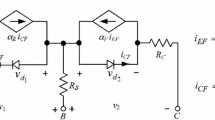Abstract
Diagnosing analog systems, i.e. systems for which physical quantities vary over time in a continuous range is, in itself, a difficult problem. Analog electronic circuits, especially those with feedback loops, raise new difficulties that cannot be solved by using classical techniques. This paper shows how model-based diagnosis theory can be used to diagnose analog circuits. The two main tasks for making the theory applicable to real size problems will be emphasized: the modeling of the system to be diagnosed, and the building of efficient conflict recognition engines adapted to the formalism used for the modeling. This will be illustrated through the description of two systems. The first one, DEDALE, only considers failures observable in quiescent mode. It uses qualitative modeling based on relative orders of magnitude relations, for which an axiomatics is given, thus allowing a symbolic solver for checking consistency of such relations to be developed. The second one, CATS/DIANA, deals with time variations. It uses modeling based on numeric intervals, arrays of such intervals to represent transient signals, and an ATMS-like domain-independent conflict recognition engine, CATS. This engine is able to work on such data and to achieve interval propagation through constraints in such a way as to focus on the detection of all minimal nogoods. It is thus well adapted for diagnosing continuous time-varying physical systems. Experimental results of the two systems are given through various types of circuits.
Similar content being viewed by others
References
P. Dague, P. Devès and O. Raiman, Troubleshooting: when modeling is the trouble,Proc. AAAI Conf., Seattle, 1987.
P. Dague, P. Devès, P. Luciani and P. Taillibert, Analog systems diagnosis,Proc. 9th ECAI, Stockholm, 1990.
P. Dague, P. Devès, O. Jehl, P. Luciani and P. Taillibert, When oscillators stop oscillating,Proc. 12th IJCAI, Sydney, 1991.
R. Reiter, A theory of diagnosis from first principles, Artificial Intelligence 32 (1987).
J. de Kleer and B.C. Williams, Diagnosing multiple faults, Artificial Intelligence 32 (1987).
G. Loveday,Electronic Testing and Fault Diagnosis, 2nd Ed. (Longman Scientific and Technical, 1989).
R.-W. Liu,Selected Papers on Analog Fault Diagnosis, Advances in Circuits and Systems (IEEE Press, 1987).
J. de Kleer and B.C. Williams, Diagnosis with behavioral modes,Proc. 11th IJCAI, Detroit, 1989.
P. Struss and O. Dressler, Physical negation — Integrating fault models into the general diagnostic engine,Proc. 11th IJCAI, Detroit, 1989.
W. Hamscher, XDE: Diagnosing devices with hierarchic structure and known component failure modes,Proc. 6th IEEE Conf. on AI Applications, Santa Barbara, 1990.
J.S. Brown, R.R. Burton and J. de Kleer, Pedagogical, natural language and knowledge engineering techniques in SOPHIE I, II and III, in: D. Sleeman and J.S. Brown (eds.),Intelligent Tutoring Systems (Academic Press, 1982).
J. de Kleer and J.S. Brown, Model-based diagnosis in SOPHIE III, in: W. Hamscher, L. Console and J. de Kleer (eds.),Readings in Model-Based Diagnosis (Morgan Kaufmann, 1992).
J. Ebers and J. Moll, Large signal behavior of junction transistors,Proc. IRE, Vol. 42, 1954, pp. 1761–1772.
J. de Kleer, How circuits work, Artificial Intelligence 24 (1984).
O. Raiman, Order of magnitude reasoning,Proc. AAAI Conf., Philadelphia, 1986.
P. Dague, Order of magnitude revisited,2nd Int. Workshop on Qualitative Physics, Paris, 1988.
P. Dague, Symbolic reasoning with relative orders of magnitude,Proc. 13th IJCAI, Chambéry, 1993.
P. Dague, Numeric reasoning with relative orders of magnitude,Proc. AAAI Conf., Washington, 1993.
A.L. Brown, Qualitative knowledge, causal reasoning, and the localization of failures, Technical Report TR-362, Artificial Intelligence Laboratory, MIT (1976).
K. Sierzega and R. Rastogi, Model-based reasoning finds Analog PCB faults, Electronics Test (March 1990) pp. 26–30.
B.C. Williams, Doing time: Putting qualitative reasoning on firmer ground,Proc. AAAI Conf., Philadelphia, 1986.
W. Hamscher, Temporally coarse representation of behavior for model-based troubleshooting of digital circuits,Proc. 11th IJCAI, Detroit, 1989.
Y. Pan, Qualitative reasoning with deep-level mechanism models for diagnoses of mechanism failures,Proc. 1st IEEE Conf. on AI Applications, Denver, 1984.
H.T. Ng, Model-based, multiple fault diagnosis of time varying, continuous physical devices,Proc. 6th IEEE Conf. on AI Applications, Santa Barbara, 1990.
H. Beringer and B. de Backer, Diagnosing systems modeled with piecewise linear constraints,Tools for Artificial Intelligence (IEEE, Washington, 1990).
J. de Kleer, An assumption-based TMS, Artificial Intelligence 28 (1986).
E. Davis, Constraint propagation with interval labels, Artificial Intelligence 32 (1987).
R. Moore,Interval Analysis, Series in Automatic Computation (Prentice-Hall, 1966).
P. Dague, O. Jehl and P. Taillibert, An interval propagation and conflict recognition engine for diagnosing continuous dynamic systems,Lecture Notes in Artificial Intelligence, Vol. 462 (Springer, Vienna, 1990).
O. Raiman, Diagnosis as a trial: The alibi principle,Working Notes of the International Workshop on Model-Based Diagnosis, Paris, 1989.
P. Devès, C. Fischer and P. Taillibert, An alternative to expert systems for electrical diagnosis,Future Generation Computer Systems, Vol. 7 (1991).
Author information
Authors and Affiliations
Additional information
This article is the synthesis of work carried out jointly with O. Jehl and O. Raiman from IBM France and P. Devès, P. Luciani and P. Taillibert from Dassault Electronique. Parts of this article come from the papers [1–3] and my thanks go to AAAI Press, Wiley and Morgan Kaufmann for permission to reprint these extracts.
Rights and permissions
About this article
Cite this article
Dague, P. Model-based diagnosis of analog electronic circuits. Ann Math Artif Intell 11, 439–492 (1994). https://doi.org/10.1007/BF01530755
Issue Date:
DOI: https://doi.org/10.1007/BF01530755




